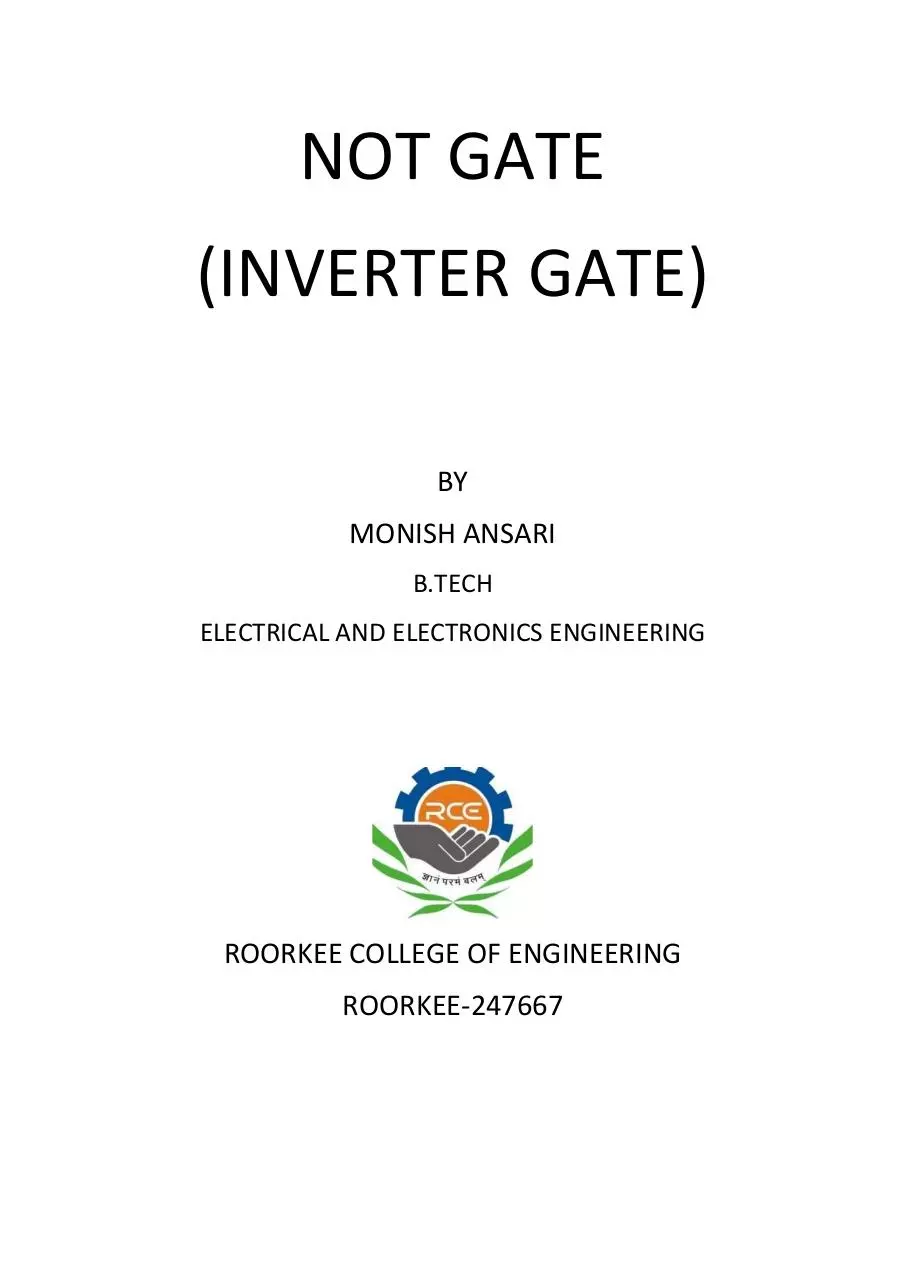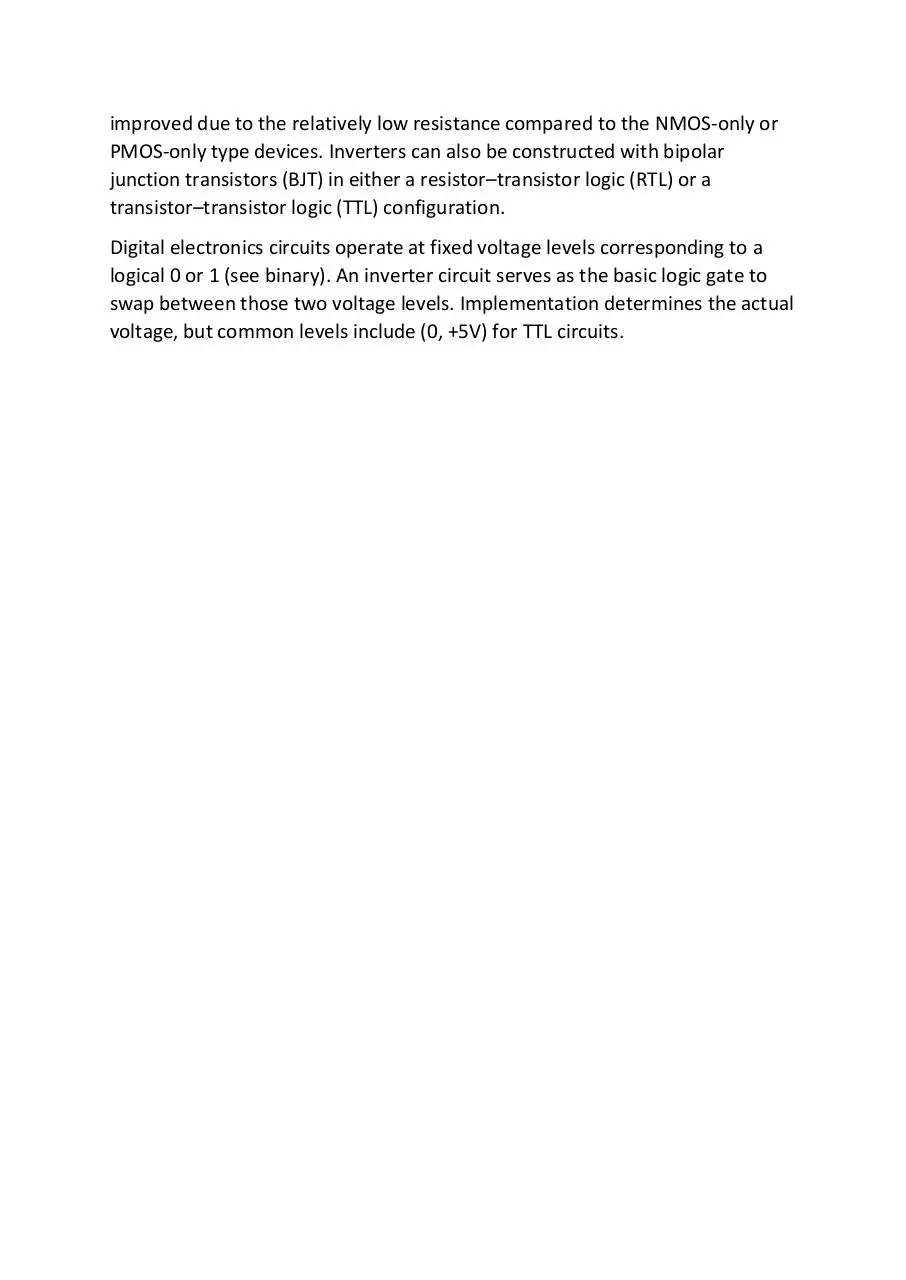Digital logic, an inverter or NOT gate (PDF)
File information
Author: Monish Ansari
This PDF 1.5 document has been generated by Microsoft® Word 2016, and has been sent on pdf-archive.com on 23/03/2018 at 08:26, from IP address 117.247.x.x.
The current document download page has been viewed 436 times.
File size: 795 KB (14 pages).
Privacy: public file





File preview
NOT GATE
(INVERTER GATE)
BY
MONISH ANSARI
B.TECH
ELECTRICAL AND ELECTRONICS ENGINEERING
ROORKEE COLLEGE OF ENGINEERING
ROORKEE-247667
TABLE OF CONTENT
ACKNOWLEDGEMENT
ABSTRACT
INTRODUCTION
THEORY
IMPLEMENTATION
BIBLIOGRAPHY
ACKNOWLEDGEMENT
Foremost, I would like to express my sincere gratitude to my advisor prof. Nisha
Dhiman for the continuous support of my Project Orientation Program, for her
patience, motivation, enthusiasm, and immense knowledge. Her guidance helped me in all
the time of research and writing of this thesis. I could not have imagined having a
better advisor and mentor for my POP.
Besides my advisor, I would like to thank the rest of my thesis committee:Prof.
Ishampal Chandra,Prof.Priyanka Rana , for their encouragement, insightful comments,
and hard questions.
My sincere thanks also goes to Dr. Sangram Bana for offering me the opportunities and
leading me working on diverse exciting projects.
I thank my fellow labmates in Roorkee College of engineering,Prince Sharma and Satya
Narayan Rai for the stimulating discussions, for the sleepless nights we were working
together before deadlines, and for all the fun we have had in the last few days.I am
grateful to prof. Shubham Sharma for enlightening me the first glance of research.
I would also like to thank my college ROORKEE COLLEGE OF ENGINEERING for
providing me a platform to show my talent and hardworks to others,and give my best to
my country.
Last but not the least, I would like to thank my family: my parents Meena and
Khursheed Ali for giving birth to me at the first place and supporting me spiritually
throughout my life.
ABSTRACT
In digital logic, an inverter or NOT gate is a logic gate which implements logical
negation. The truth table is shown on the right.
An inverter circuit outputs a voltage representing the opposite logic-level to its
input. Its main function is to invert the input signal applied. If the applied input
is low then the output becomes high and vice versa. Inverters can be
constructed using a single NMOS transistor or a single PMOS transistor coupled
with a resistor. Since this 'resistive-drain' approach uses only a single type of
transistor, it can be fabricated at low cost. However, because current flows
through the resistor in one of the two states, the resistive-drain configuration
is disadvantaged for power consumption and processing speed. Alternatively,
inverters can be constructed using two complementary transistors in a CMOS
configuration. This configuration greatly reduces power consumption since one
of the transistors is always off in both logic states. Processing speed can also be
improved due to the relatively low resistance compared to the NMOS-only or
PMOS-only type devices. Inverters can also be constructed with bipolar
junction transistors (BJT) in either a resistor–transistor logic (RTL) or a
transistor–transistor logic (TTL) configuration.
Digital electronics circuits operate at fixed voltage levels corresponding to a
logical 0 or 1 (see binary). An inverter circuit serves as the basic logic gate to
swap between those two voltage levels. Implementation determines the actual
voltage, but common levels include (0, +5V) for TTL circuits.
INTRODUCTION
Logic gates are the basic building blocks of digital logic circuits as well as digital
electronics. A gate is defined as a logic device which computes functionally on a
2 valued input signal. Logic gates are of many types such as OR, AND, NOR,
NAND, EX –OR and NOT etc. Among these, all gates have two inputs and one
output except NOT gate. NOT gate has only one input and one output. This gate
produces the reverse output of applied input. So this gate is also called as ‘Digital
Inverter’.
NOT Gate Logic Symbol and Boolean Expression
We know the NOT gate is an inverter, which inverts or reverses the input.. So
the output is represented by ‘-’ bar symbol of the input. The Boolean expression
of the NOT gate is Z =X .̅ Pronounced as “Z is equal to X bar”. The logic symbol of
the NOT gate is shown in below figure.
If X is the input and Z is the output, then if X = 0, then Z = 1
If X = 1, then Z = 0.
The bubble at the output port represents the inverting operation. That means
for high logic signal input, the output of the NOT gate will be LOW, similarly for
low logic signal input the output of NOT gate will be HIGH. We can easily
understand this by truth table stated below.
THEORY
Explanation of Not gate with light switch circuit
The NOT gate can be easily understood by using a LED (light emitted Diode)
circuit. This is also called Light switch circuit. In this circuit, NOT gate functions
like an electronic switch. When it got high input, the LED connected at the
output will be OFF, as the output of NOT gate becomes 0. In the same way, when
the logic gate is connected with LOW input, the LED will be ON, as the output
becomes 1. The Light switching circuit with NOT gate is shown below.
Here we connect an alterable switch with the NOT gate and the output of NOT
gate is connected to a LED. An LED is an electronic device which will ON and off
when it receives high voltage and low voltage respectively. When the switch is
connected to +5 V, the switch is on position so the LED emits light. When the
NOT gate is connected to Ground, the LED will OFF so it doesn’t emit any light.
Pulsed Operation
When we apply a pulse signal to the NOT gate, it will ON and OFF for HIGH and
LOW levels respectively. This means,
Download Digital logic, an inverter or NOT gate
Digital logic, an inverter or NOT gate.pdf (PDF, 795 KB)
Download PDF
Share this file on social networks
Link to this page
Permanent link
Use the permanent link to the download page to share your document on Facebook, Twitter, LinkedIn, or directly with a contact by e-Mail, Messenger, Whatsapp, Line..
Short link
Use the short link to share your document on Twitter or by text message (SMS)
HTML Code
Copy the following HTML code to share your document on a Website or Blog
QR Code to this page

This file has been shared publicly by a user of PDF Archive.
Document ID: 0000748487.